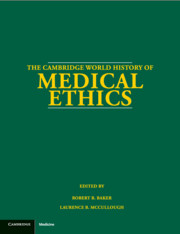Book contents
- Frontmatter
- PART I AN INTRODUCTION TO THE HISTORY OF MEDICAL ETHICS
- PART II A CHRONOLOGY OF MEDICAL ETHICS
- PART III DISCOURSES OF MEDICAL ETHICS THROUGH THE LIFE CYCLE
- PART IV THE DISCOURSES OF RELIGION ON MEDICAL ETHICS
- 9 The Discourses of Hindu Medical Ethics
- 10 The Discourses of Buddhist Medical Ethics
- 11 The Discourses of Confucian Medical Ethics
- 12 The Discourses of Early Christian Medical Ethics
- 13 The Discourses of Orthodox Christian Medical Ethics
- 14 The Discourses of Roman Catholic Medical Ethics
- 15 The Discourses of Protestant Medical Ethics
- 16 The Discourses of Jewish Medical Ethics
- 17 The Discourses of Islamic Medical Ethics
- PART V THE DISCOURSES OF PHILOSOPHY ON MEDICAL ETHICS
- PART VI THE DISCOURSES OF PRACTITIONERS ON MEDICAL ETHICS
- PART VII THE DISCOURSES OF BIOETHICS
- PART VIII DISCOURSES ON MEDICAL ETHICS AND SOCIETY
- Appendix: Biographies: Who Was Who in the History of Medical Ethics
- Bibliography
- Index
11 - The Discourses of Confucian Medical Ethics
from PART IV - THE DISCOURSES OF RELIGION ON MEDICAL ETHICS
Published online by Cambridge University Press: 28 May 2012
- Frontmatter
- PART I AN INTRODUCTION TO THE HISTORY OF MEDICAL ETHICS
- PART II A CHRONOLOGY OF MEDICAL ETHICS
- PART III DISCOURSES OF MEDICAL ETHICS THROUGH THE LIFE CYCLE
- PART IV THE DISCOURSES OF RELIGION ON MEDICAL ETHICS
- 9 The Discourses of Hindu Medical Ethics
- 10 The Discourses of Buddhist Medical Ethics
- 11 The Discourses of Confucian Medical Ethics
- 12 The Discourses of Early Christian Medical Ethics
- 13 The Discourses of Orthodox Christian Medical Ethics
- 14 The Discourses of Roman Catholic Medical Ethics
- 15 The Discourses of Protestant Medical Ethics
- 16 The Discourses of Jewish Medical Ethics
- 17 The Discourses of Islamic Medical Ethics
- PART V THE DISCOURSES OF PHILOSOPHY ON MEDICAL ETHICS
- PART VI THE DISCOURSES OF PRACTITIONERS ON MEDICAL ETHICS
- PART VII THE DISCOURSES OF BIOETHICS
- PART VIII DISCOURSES ON MEDICAL ETHICS AND SOCIETY
- Appendix: Biographies: Who Was Who in the History of Medical Ethics
- Bibliography
- Index
Summary
INTRODUCTION: THE CONFUCIAN VIEW OF MEDICINE: THE ART OF REN (HUMANITY)
The Traditional Chinese Understanding of Health and Disease
The beginning of Chinese medicine is generally attributed to Shen Nong (the Heavenly Husbandman), a legendary emperor who, living circa 2700 BCE, introduced agriculture and had personally tasted the hundred types of plants to discover their medicinal values. He is also supposed to have introduced the technique of acupuncture; however, he does not figure in the story of the cardinal classic of Chinese medicine, Huang Di Nei Jing (The Yellow Emperor's Internal Medicine). This work features Huang Di. the Yellow Emperor, who is believed to have lived at the same time as Shen Nong and was, a legendary emperor revered by both Confucians and Daoists (Qian 1987).
The Yellow Emperor's Internal Medicine was most probably compiled during the Eastern Han dynasty (25–220) (Liao 1993, 55–80). It includes the most distinguished texts of ancient Chinese medicine, integrates and theorizes various healing arts, and sets down the foundational principles of Chinese learned medicine and its written traditions. It shares the same Chinese concept of the universe as philosophy, science, politics, and indeed nearly everything else traditionally Chinese (Ho and Lisowski 1997, 17). First, it can be understood as offering a particular metaphysics of qi as the basic elements of the universe. Qi is difficult to translate.
- Type
- Chapter
- Information
- The Cambridge World History of Medical Ethics , pp. 195 - 201Publisher: Cambridge University PressPrint publication year: 2008



